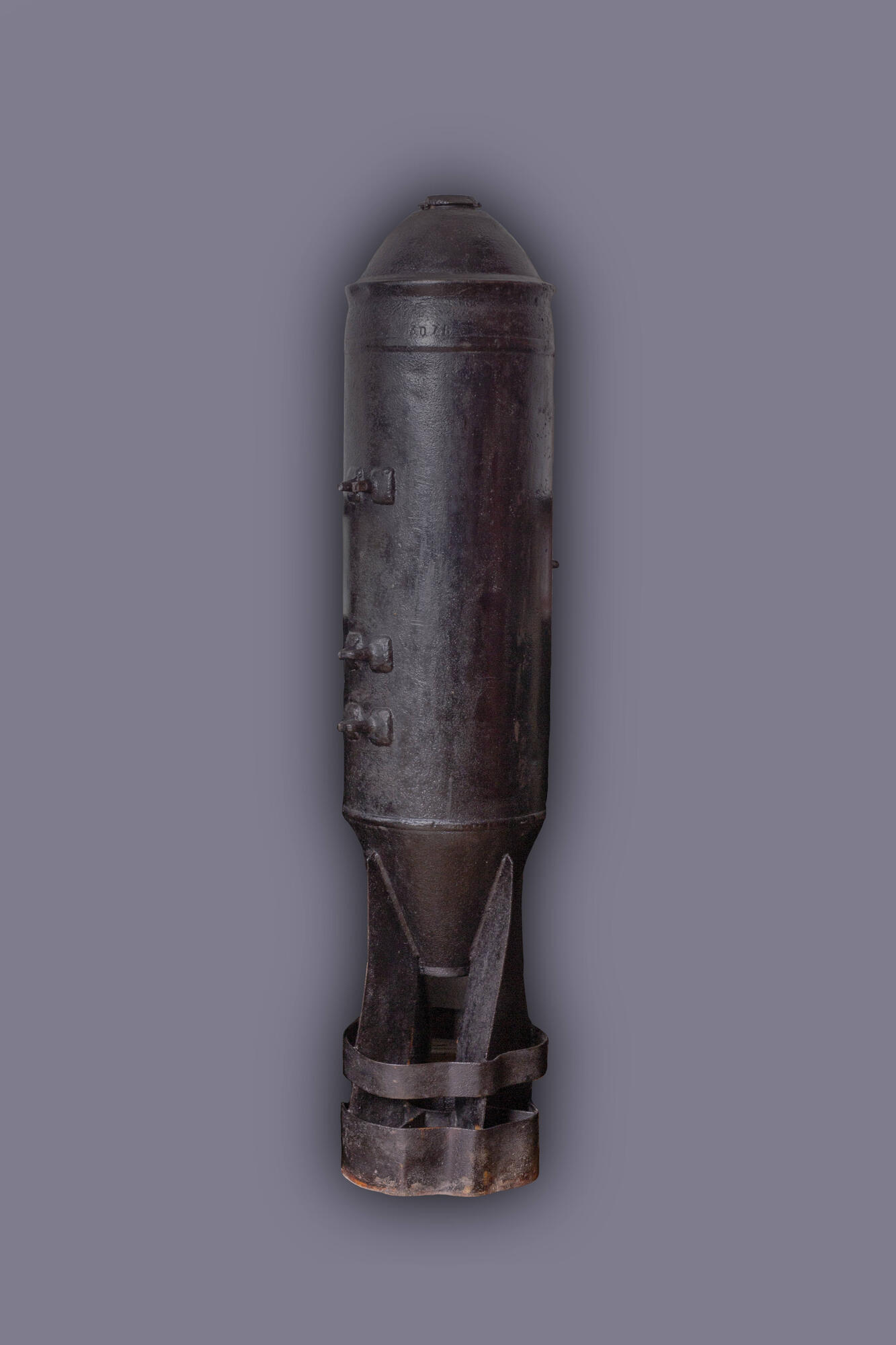An aerial bomb is one of the main types of aviation weapons. It is dropped from an airplane or other aircraft by separating from its suspension by gravity or at low initial velocity by forced separation.
The German air forces had in service a fairly wide range of aerial bombs: fragmentation, fragmentation-explosive, high-explosive, incendiary, chemical and others. The high-explosive bombs were classified according to caliber (weight) and wall thickness. The main calibers are 50, 250, 500, 1,000, 1,800 and 2,500 kg. Based on the thickness of the casing walls, a distinction was made between thin-walled SC bombs with a cylindrical center section, a welded nose cone and a screwed-on stabilizer tail cone (the bomb was loaded through the bottom) and thick-walled SD bombs — cast in one piece, the tail cone being bolted on after the bomb was loaded. Armor-piercing and high-explosive bombs with rocket propulsion for hitting armored or reinforced concrete targets were made on the basis of the thick-walled bombs. They were designated PC and PS. The bombs were fitted with side fuses. The suspension system was in the form of a single lug or, for heavy bombs, a pad.
To reduce the depth of penetration into the ground and to increase the shockwave effect, a ring or cast-iron ploughshare-like tips were welded to the head end of some of the bombs. The high-explosive bombs were painted grey for calibers up to 1,000 kg, and light blue for those above 1,000 kg. Germans welded so called “whistles” to the stabilizers of some of the high-explosive and fragmentation bombs. A shrill whistling sound accompanied the fall of such bombs, which caused panic in the infantry recruits. For experienced units the whistle served as a warning of danger.
The 250kg German aerial high-explosive bomb was found by members of the Search club in Atamansky Forest in October 1976. This bomb was dropped on Stary Oskol in 1942. On June 28, 1942 the city was attacked several times by units of Nazi air squadron of Baron Richthofen. Despite the resistance of the Soviet artillery, the Nazi aircraft caused heavy damage — the city was on fire. Bombing continued until July 2. It was during this period that most civilians were killed.
The German air forces had in service a fairly wide range of aerial bombs: fragmentation, fragmentation-explosive, high-explosive, incendiary, chemical and others. The high-explosive bombs were classified according to caliber (weight) and wall thickness. The main calibers are 50, 250, 500, 1,000, 1,800 and 2,500 kg. Based on the thickness of the casing walls, a distinction was made between thin-walled SC bombs with a cylindrical center section, a welded nose cone and a screwed-on stabilizer tail cone (the bomb was loaded through the bottom) and thick-walled SD bombs — cast in one piece, the tail cone being bolted on after the bomb was loaded. Armor-piercing and high-explosive bombs with rocket propulsion for hitting armored or reinforced concrete targets were made on the basis of the thick-walled bombs. They were designated PC and PS. The bombs were fitted with side fuses. The suspension system was in the form of a single lug or, for heavy bombs, a pad.
To reduce the depth of penetration into the ground and to increase the shockwave effect, a ring or cast-iron ploughshare-like tips were welded to the head end of some of the bombs. The high-explosive bombs were painted grey for calibers up to 1,000 kg, and light blue for those above 1,000 kg. Germans welded so called “whistles” to the stabilizers of some of the high-explosive and fragmentation bombs. A shrill whistling sound accompanied the fall of such bombs, which caused panic in the infantry recruits. For experienced units the whistle served as a warning of danger.
The 250kg German aerial high-explosive bomb was found by members of the Search club in Atamansky Forest in October 1976. This bomb was dropped on Stary Oskol in 1942. On June 28, 1942 the city was attacked several times by units of Nazi air squadron of Baron Richthofen. Despite the resistance of the Soviet artillery, the Nazi aircraft caused heavy damage — the city was on fire. Bombing continued until July 2. It was during this period that most civilians were killed.



